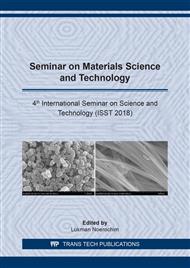[1]
P. Deshmukh, J. Bhatt, D. Peshwe, and S. Pathak, Determination of Silica Activity Index and XRD, SEM and EDS Studies of Amorphous SiO2 Extracted from Rice Husk Ash,, Trans. Indian Inst. Met., vol. 65, no. 1, p.63–70, Feb. (2012).
DOI: 10.1007/s12666-011-0071-z
Google Scholar
[2]
N. Soltani, A. Bahrami, M. I. Pech-Canul, and L. A. González, Review on the physicochemical treatments of rice husk for production of advanced materials,, Chem. Eng. J., vol. 264, p.899–935, Mar. (2015).
DOI: 10.1016/j.cej.2014.11.056
Google Scholar
[3]
V. Meynen, P. Cool, and E. F. Vansant, Verified syntheses of mesoporous materials,, Microporous Mesoporous Mater., vol. 125, no. 3, p.170–223, Oct. (2009).
DOI: 10.1016/j.micromeso.2009.03.046
Google Scholar
[4]
S. Parvanian, S. M. Mostafavi, and M. Aghashiri, Multifunctional nanoparticle developments in cancer diagnosis and treatment,, Sens. Bio-Sensing Res., vol. 13, p.81–87, Apr. (2017).
DOI: 10.1016/j.sbsr.2016.08.002
Google Scholar
[5]
A. Liberman, N. Mendez, W. C. Trogler, and A. C. Kummel, Synthesis and surface functionalization of silica nanoparticles for nanomedicine,, Surface Science Reports, vol. 69, no. 2–3. (2014).
DOI: 10.1016/j.surfrep.2014.07.001
Google Scholar
[6]
M. Bhagiyalakshmi, L. J. Yun, R. Anuradha, and H. T. Jang, Utilization of rice husk ash as silica source for the synthesis of mesoporous silicas and their application to CO2 adsorption through TREN/TEPA grafting,, J. Hazard. Mater., vol. 175, no. 1–3, p.928–938, Mar. (2010).
DOI: 10.1016/j.jhazmat.2009.10.097
Google Scholar
[7]
H. Purwaningsih, V. M. Pratiwi, S. A. B. Purwana, H. Nurdiansyah, Y. Rahmawati, and D. Susanti, Fabrication of mesoporous silica nanoparticles by sol gel method followed various hydrothermal temperature,, in AIP Conference Proceedings, 2018, vol. (1945).
DOI: 10.1063/1.5030274
Google Scholar
[8]
A. R. Maurice and H. Faouzi, Synthesis and Characterization of Amorphous Silica Nanoparitcles from Aqueous Silicates Uisng Cationic Surfactants,, J. Met. Mater. Miner., vol. 24, no. 1, p.37–42, (2014).
Google Scholar
[9]
T.-H. Liou, Preparation and characterization of nano-structured silica from rice husk,, Mater. Sci. Eng. A, vol. 364, no. 1–2, p.313–323, Jan. (2004).
DOI: 10.1016/j.msea.2003.08.045
Google Scholar
[10]
L. Zhong, T. Shi, and L. Guo, Preparation and morphology of porous SiO2 ceramics derived from fir flour templates,, J. Serbian Chem. Soc., vol. 75, no. 3, p.385–394, (2010).
DOI: 10.2298/jsc090410010z
Google Scholar
[11]
U. Junko, I. Hisashi, and K. Katsuyoshi, Polysaccharide Hydrolysis and Metallic Impurities Removal Behavior of Rice Husks in Citric Acid Leaching Treatment,, Trans. JWRI, vol. 38, (2009).
Google Scholar
[12]
R. A. Bakar, R. Y. Gan, and S. Neon, Production of High Purity Amorphous Silica from Rice Husk,, Procedia Chem., vol. 19, p.189–195, (2016).
DOI: 10.1016/j.proche.2016.03.092
Google Scholar
[13]
S. Chandrasekhar, K. G. Satyanarayana, P. N. Pramada, P. Raghavan, and T. N. Gupta, Review Processing, properties and applications of reactive silica from rice husk—an overview,, J. Mater. Sci., vol. 38, no. 15, p.3159–3168, (2003).
DOI: 10.1002/chin.200406243
Google Scholar
[14]
D. Singh, R. Kumar, A. Kumar, and K. N. Rai, Synthesis and characterization of rice husk silica, silica-carbon composite and H3PO4 activated silica,, Cerâmica, vol. 54, no. 330, p.203–212, Jun. (2008).
DOI: 10.1590/s0366-69132008000200011
Google Scholar
[15]
Freddy Kleitz, F. Schüth, W. Grünert, and M. Epple, Ordered Mesoporous Materials: Template Removal, Frameworks and Morphology,, Universität Bochum, (2002).
Google Scholar
[16]
E. M. Johansson, Controlling the Pore Size and Morphology of Mesoporous Silica,, Linköpings Universitet, (2010).
Google Scholar
[17]
Z. ALOthman, A Review: Fundamental Aspects of Silicate Mesoporous Materials,, Materials (Basel)., vol. 5, no. 12, p.2874–2902, Dec. (2012).
DOI: 10.3390/ma5122874
Google Scholar


